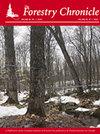美味乳菇和玫瑰根霉对接种尖孢镰刀菌和轮叶镰刀菌的苏格兰松和石松种子和幼苗的影响
IF 0.8
4区 农林科学
Q3 FORESTRY
引用次数: 5
摘要
对两株可食用外生菌根真菌(ECM)——美味乳酸菌(Lactarius deliciosus)和玫瑰根瘤菌(Rhizopogon roseolus)进行了抑菌试验,研究了两株可食用外生菌根真菌(ECM)对红松(Pinus sylvestris)和石松(Pinus pinea)种子和幼苗枯萎的病原菌尖孢镰刀菌(Fusarium oxysporum)和黄萎病菌(F. verticillioides)的抑菌效果。通过种子试验和8周龄幼苗共接种ECM和镰刀菌,评价了ECM对石松和松根际镰刀菌的影响。种子试验表明,黄萎病菌处理显著降低了苏格兰松种子的发芽率,但与玫瑰红松共接种时没有这种影响。在石松中,尖孢镰刀菌与美味乳杆菌共接种比单独接种有更高的发芽率。在幼苗试验中,镰刀菌对苏格兰松和石松的影响不明显,两种试验均未观察到植物生长相关变量的明显变化。在种子试验中,红毛霉对苏格兰松和石松幼苗的根定殖率分别为15.5%和12%,在幼苗试验中分别为21.6%和11%。美味乳酸菌根仅在苏格兰松幼苗中发现(10%)。玫瑰根瘤菌和美味乳杆菌是两种很有希望在苗圃保护松树幼苗免受枯萎病的真菌。本文章由计算机程序翻译,如有差异,请以英文原文为准。
Effects of Lactarius deliciosus and Rhizopogon roseolus ectomycorrhyzal fungi on seeds and seedlings of Scots and stone pines inoculated with Fusarium oxysporum and Fusarium verticillioides
Two isolates of the edible ectomycorrhizal fungi (ECM), Lactarius deliciosus and Rhizopogon roseolus, were tested against Fusarium oxysporum and F. verticillioides, causal agents of damping-off on seeds and seedlings of Scots pine (Pinus sylvestris) and stone pine (Pinus pinea). The effects of ECM on Fusarium spp. in the rhizosphere of Scots and stone pines were evaluated by: (1) co-inoculating ECM and Fusarium when seeding (seed test) and (2) co-inoculating eight-week-old seedlings (seedling test). The seed tests showed significant reduction of Scots pine seed germination when treated with F. verticillioides, but this effect was absent when co-inoculated with R. roseolus. Higher germination rates were observed in stone pine when F. oxysporum was co-inoculated with L. deliciosus than the pathogen inoculation alone. In the seedling test, Scots and stone pines were not apparently affected by Fusarium spp. No obvious changes in plant growth-related variables were observed in either assay. Root colonization of Scots and stone pine seedlings by R. roseolus was 15.5% and 12% for the seed assay, as well as 21.6% and 11% for the seedling assay. Lactarius deliciosus mycorrhizal roots were found only in Scots pine seedlings (10%). Rhizopogon roseolus and L. deliciosus are two promising fungi for pine seedling protection against Fusarium damping-off at nurseries.
求助全文
通过发布文献求助,成功后即可免费获取论文全文。
去求助
来源期刊

Forestry Chronicle
农林科学-林学
CiteScore
1.20
自引率
0.00%
发文量
6
审稿时长
18-36 weeks
期刊介绍:
The Canadian Institute of Forestry has published The Forestry Chronicle, a professional and scientific forestry journal, since 1925. The Forestry Chronicle is published to provide information to forest practitioners about professional and scientific management of forests and their resources. The Forestry Chronicle provides forest practitioners in Canada and around the world with a means to communicate with their peers in the professional community.
 求助内容:
求助内容: 应助结果提醒方式:
应助结果提醒方式:


